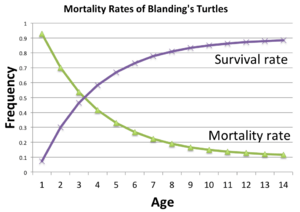Blanding's turtle facts for kids
The Blanding's turtle (scientific name: Emys blandingii or Emydoidea blandingii) is a type of turtle found in North America. These turtles mostly live near and south of the Great Lakes.
Contents
What Does a Blanding's Turtle Look Like?
The Blanding's turtle has a dark, dome-shaped upper shell, which is called a carapace. It also has a bright yellow neck, which makes it easy to spot! Its dark shell often has yellow spots scattered across it.
This turtle is sometimes called a "semi-box turtle." This is because its bottom shell, called the plastron, has a special hinge. This hinge lets the turtle pull the front part of its bottom shell tightly against its top shell. This helps the turtle hide and protect itself when it feels scared or threatened.
Where Do Blanding's Turtles Live?
Blanding's turtles like to live in wet areas called wetlands. These places have shallow water, like rivers and streams, and are often close to sandy, higher ground. The wetlands are perfect for them because they have lots of water plants for the turtles to eat and hide in.
You can find Blanding's turtles in different parts of North America. They live in the Upper Midwest and New England regions of the United States. They are also found in southeastern Canada.
The Life of a Blanding's Turtle
Blanding's turtles spend the cold winter months in muddy areas. They like deep marshes, quiet pools, ponds, and streams. When spring arrives, they come out and move to temporary wet areas. These spots are good for them to find a partner and lay eggs.
Turtles usually become old enough to have babies around 12 years of age. They lay eggs only once a year. A female turtle typically lays between 10 and 26 eggs at a time.
The eggs are laid away from the water, usually in sandy spots. The baby turtles, called hatchlings, start to leave their nests from mid-August to early October. Blanding's turtles are known to live for a very long time, often more than 70 years!
Images for kids
See also
 In Spanish: Emydoidea blandingii para niños
In Spanish: Emydoidea blandingii para niños



